
Menu
Do you want to know the best almond milk for baby? The recent explosion of plant-based milks on the market has opened a new can of worms for parents of little ones. Right next to the cow’s milk, you’ll find a ton of other milk variations. Coconut milk, hemp milk, rice milk, oat milk, almond milk, cashew milk, and several other plant-based milk alternatives and blends. The dozens of choices in the refrigerated cases at your local grocery store may have you wondering what type of milk is best for your baby once they transition off breastmilk or formula.
Whether you are working around a food allergy or lactose intolerance, following a vegan diet, or simply curious about how cow’s milk and popular milk alternatives stack up against each other, I’m here to help you navigate the growing milk aisle and choose the best source of nutrition for your baby.
I personally enjoy the taste of almond milk, so I get why you’d consider it for your little one! I’m a Registered Dietitian Nutritionist with a Master of Clinical Nutrition, so you’re in good hands. I’ll walk you through the nutrition of different milk alternatives and what to consider as you make a decision that’s best for your family.

Baby’s diet should be exclusively breastmilk and/or formula for about their first 6 months. Once you start solids around 6 months, the best milk for babies is still breastmilk and/or formula milk to meet their nutrient needs. The American Academy of Pediatrics recommends babies under 1 year of age only drink breastmilk, formula, and minimal amounts of water. Breastmilk and formula supply all the necessary nutrients for the first 6 months of life and are an important continued complement to solid foods from 6 months until 1 year.
However, when you start solids, they can also start to have tastes of other milks, just not as a replacement for their breastmilk or formula. This should primarily occur by using milk as an ingredient in other dishes at this point. For example, you may make oatmeal with some cow milk, goat milk, or nondairy milk. Or you may make a sauce that uses milk as one of the ingredients.
You should not exceed around 4 ounces a day of any other kind of milk besides breastmilk or formula for a baby under 1.
Baby formula is appropriate up through 12 months of age. Once they turn 1 year old, then you can start using cow’s milk or other types of milk as a beverage in your baby’s diet. Technically, they are a toddler when they turn 1, which can be hard to believe! They still probably feel like a baby. But it’s the time to start transitioning to a toddler’s diet, and decrease the reliance on bottles and breastmilk if you haven’t already.
Not all dairy must be limited before 1 year of age. In fact, many dairy products are healthful, nutritious choices for a baby eating solid food.
There are several nutrients that are important to look at when comparing and choosing between milks. Calories are important, but protein content, fat content, vitamin D, and calcium are also vital for your baby’s brain and body development. But what exactly does your little one need?
Generally speaking, a toddler’s calorie needs are about 900-1000 calories per day. This is a general guideline, so don’t be concerned if your baby eats more than this on some days and less on others.
Fats shouldn’t be restricted in the first two years of life. By age 2+, fats can comprise about 30-35% of total calories consumed.
A good rule of thumb for protein is to divide the child’s body weight in half and aim for that many grams of protein. For example, a child who weighs 30 pounds would need about 15 grams of protein as a minimum.
Calcium needs are about 700 mg/day for children ages 1-3 and total Vitamin D consumption should be at least 600 IU, per pediatric guidelines published by the National Institute of Health and the Center for Disease Control, respectively.
Cow’s milk has an optimal ratio of some of these nutritional components. If you are making the transition from breastmilk or infant formula to cow’s milk when your baby is around 12 to 14 months, opt for whole milk– which has a more desirable fat content than skim or 2% milk and aids in healthy brain development. The nutrition of whole milk has long made it the most popular choice for babies over 1 year old in the United States. And, it is widely available, generally affordable, and an easy way to get these nutrients that young children need.
But with the recent boom in alternative milk products, there are quite a few more choices to make. We need to take a close look at the makeup of these new products to see where other milks rank in terms of getting your baby the nutrients he/she needs.
Cow’s milk and unsweetened soy milk are the only two milk options formally recommended by the AAP at this time. Unsweetened soy milk’s similar nutritional profile to cow’s milk has earned it status as a vetted non-dairy milk alternative. But we will also break down the nutrition profiles of some popular brands of almond milk, oat milk, pea protein milk, and a blended nut milk.
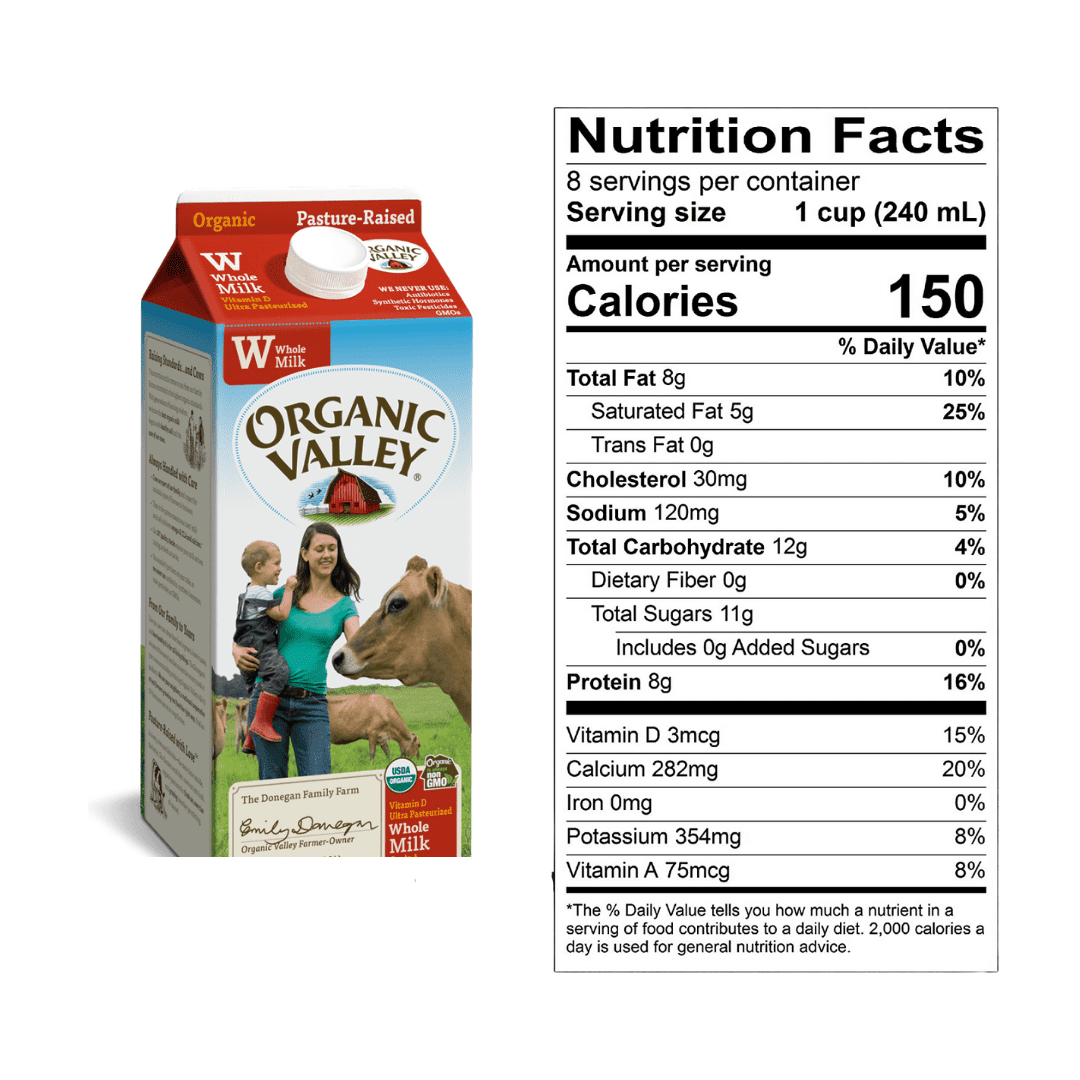
Organic Valley Whole Milk provides 150 calories, 8 grams of protein, and about 9 grams of fat per 1 cup serving. It also provides a substantial amount of vitamin D and calcium.
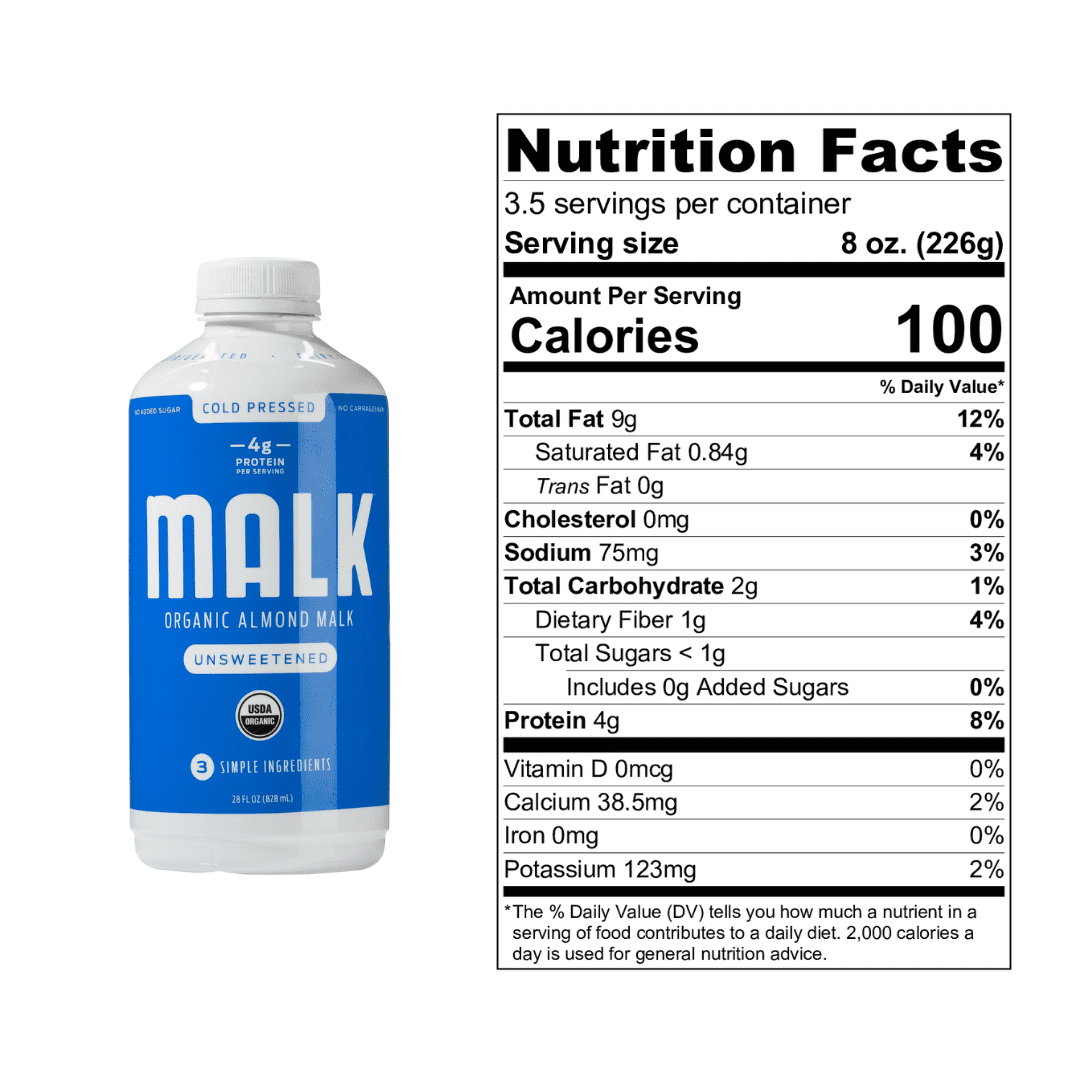
Organic Almond MALK is lower in calories compared to whole milk, has good fat content, and about half the protein content of whole cow’s milk. It contains only a fraction of the recommended amount of calcium and no vitamin D, which are essential nutrients for baby’s bone growth and development. It has an ingredient list that is simple and squeaky clean, but it lacks the fortification of some of the other non-dairy milk alternatives on this list.
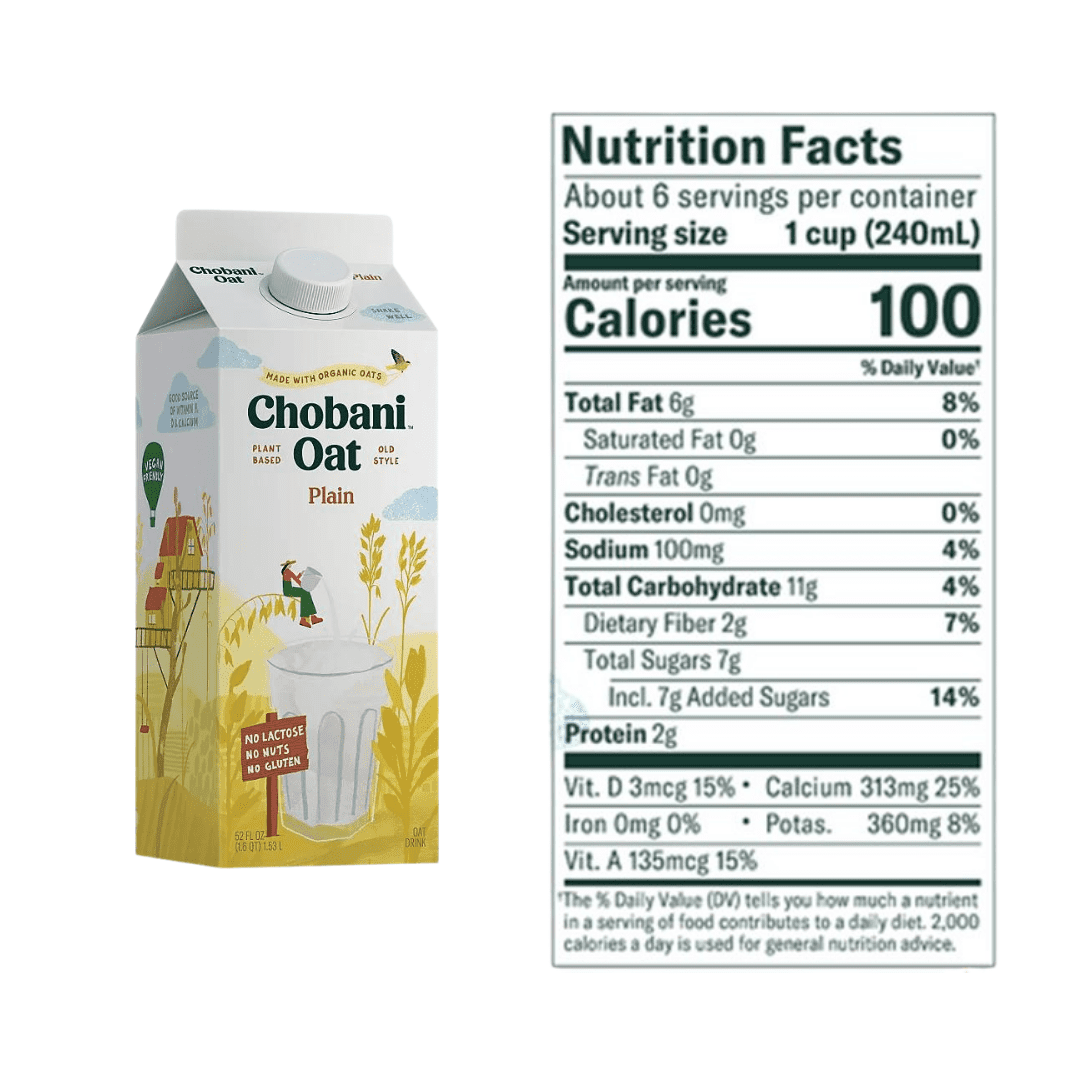
Chobani’s Oat Milk has fewer calories than whole milk, about ⅔ of the fat content, and very little protein. It provides a good amount of vitamin D and calcium and doesn’t come with any added sugar. Oat milk generally relies on small amounts of oil as an emulsifier, with this particular brand including canola oil in their blend.
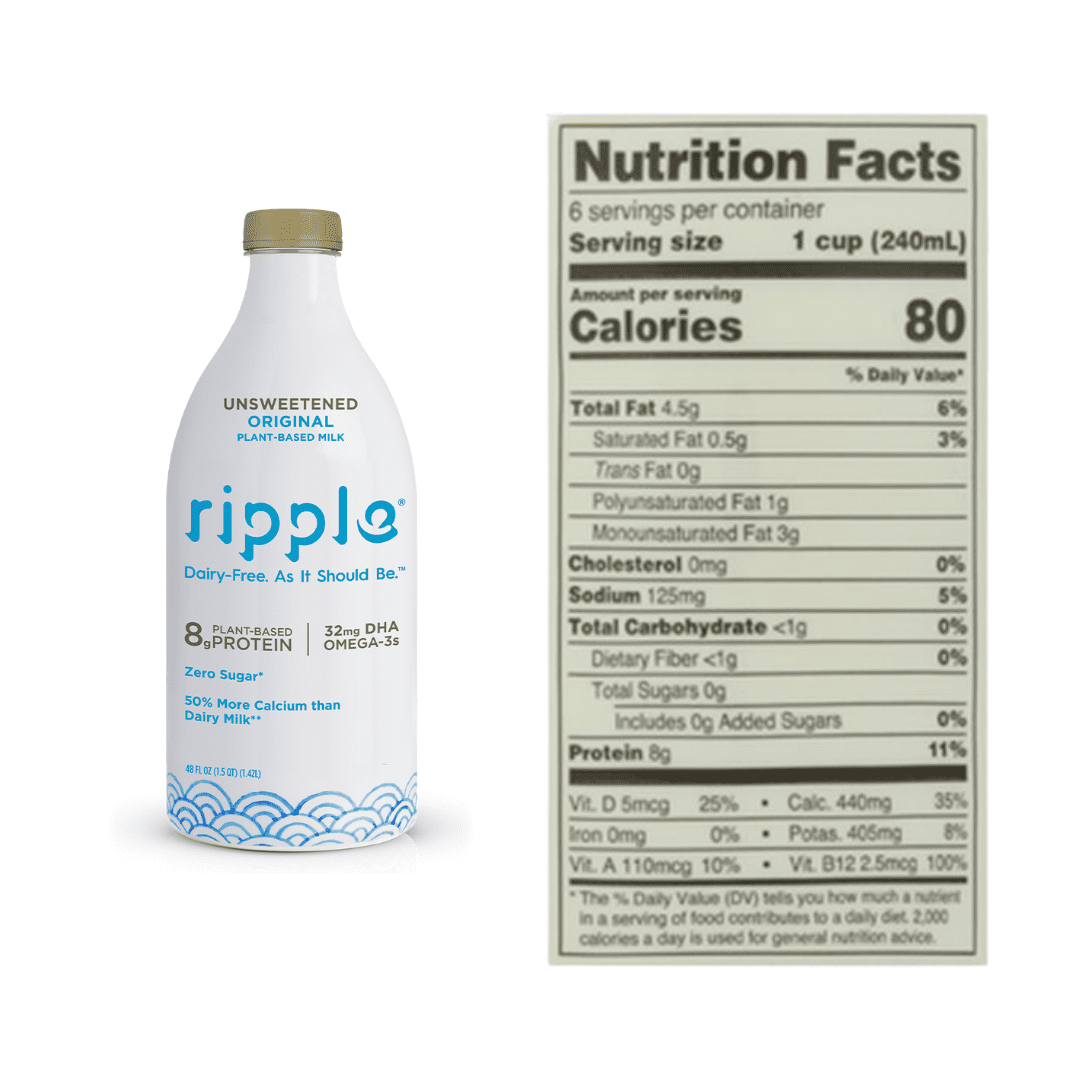
Ripple’s Unsweetened Pea Milk is very low in calories compared to all the other choices on this list, providing only 80 calories per serving. It has only half the fat content of cow’s milk. Fat is essential for growing babies’ central nervous system, and both fat and calories should not be restricted in the first two years of life. This milk is equal in protein content to cow’s milk, and actually has more vitamin D and calcium.
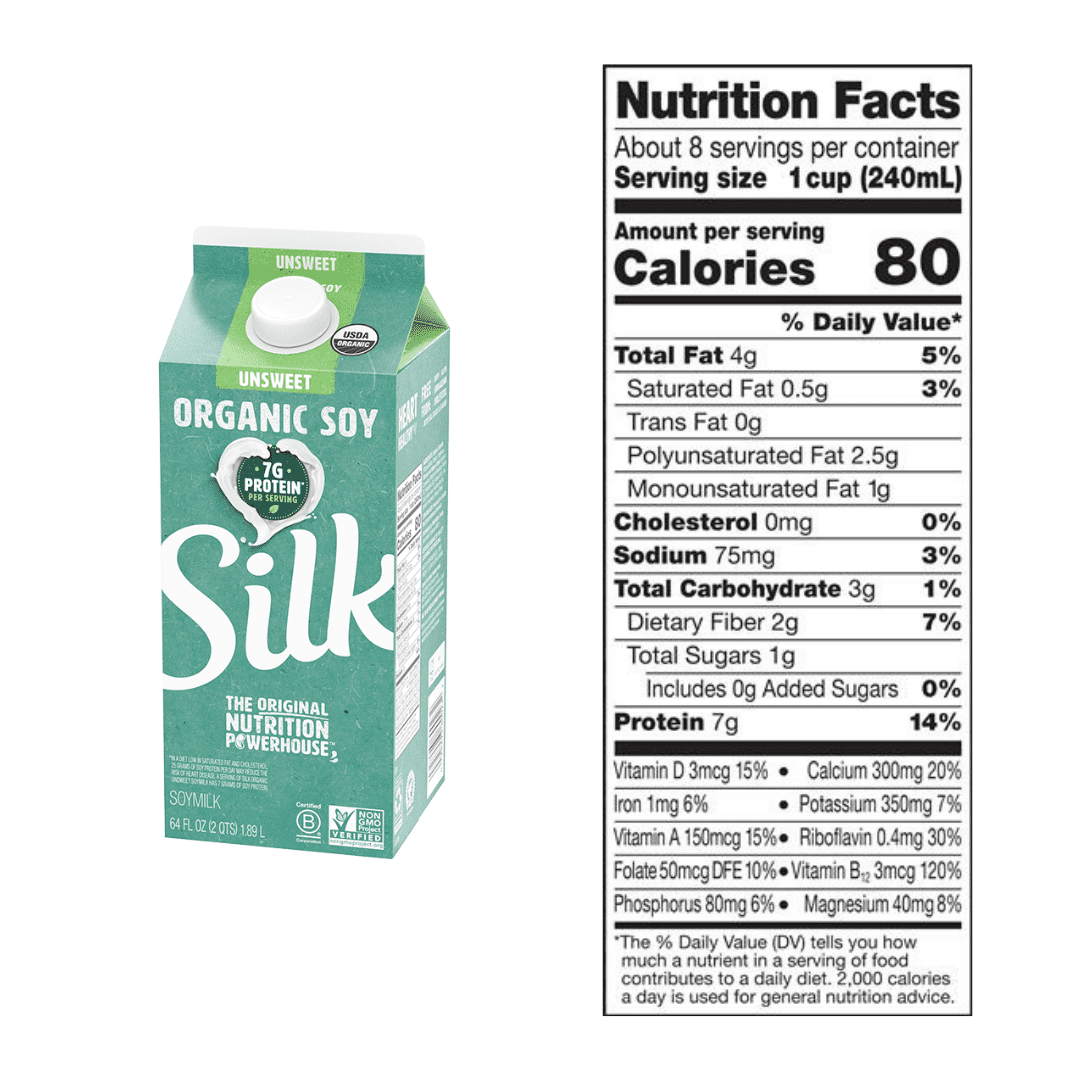
Silk’s Unsweetened Soy Milk is also relatively low in calories- about half that of cow’s milk. Its protein, vitamin D, and calcium content are similar to cow’s milk, but it has a substantially lower fat content.
This is just a sampling of the milks on the market; there are dozens of similar options-each with unique nutritional profiles. If you are a parent wondering what milk to give your baby over one, glance at the nutrition facts labels and check out their similarities and differences. Pay close attention to calories, fat, protein, vitamin D, and calcium. Also know that calcium is typically higher in non-dairy alternatives because it is not absorbed as well as the calcium in cow’s milk. So your child isn’t necessarily getting more calcium even though the number on the label is higher.
Here’s the catch: your baby doesn’t actually HAVE to drink milk. Babies have certain nutritional needs based on their age and development, and whole cow’s milk has a nutritional profile that meets a lot of those needs. Offering milk several times a day is an easy way to ensure those goals are being met, but it is not the only way.
Several alternative milks come close in providing ample amounts of fat, protein, and vitamins as cow’s milk. However, almond milk is a little scant in most categories. That doesn’t mean to never serve it. But it does mean that it’s not replacing the nutrients that cow’s milk would offer in the diet.
If you choose to offer your child a plant-based milk alternative that is lower in fat- like Silk Unsweetened Soy Milk- be sure that they are receiving plenty of foods in their diet with substantial fat content to balance out what the milk lacks. Some examples include:
More: Healthy Fats and Oils for Kids
If serving a milk like oat milk that has less protein, be sure to serve protein options during meals. But be aware, an overload of protein can be hard on their kidneys so there is no need to go overboard or add protein powders or supplements.
If you’re concerned your baby is on the lower end of protein intake or the milk you choose is lacking in protein, here are some options for babies and toddlers:
Baby’s nutritional needs include 400 IU of vitamin D daily through age 1, or 600 IU daily after age 1. A good way to ensure your baby gets this is with a supplement like D Drops. For under 1 click here, and for over 1 year old click here.
If your child is still receiving breast milk beyond 12 months, there is no need to introduce any other type of milk. If your child has been receiving infant formula, now may be a good time to consider making the switch to a type of milk. Toddler formulas are not currently recommended as they tend to contain quite a bit of added sugar.
Homemade milks such as almond and cashew will not have the same nutritional profile as store-bought options which are fortified with important nutrients, such as calcium and vitamin D.
Centers for Disease Control and Prevention. (2021, July 22). Vitamin D. Centers for Disease Control and Prevention. Retrieved September 28, 2021, from https://www.cdc.gov/nutrition/infantandtoddlernutrition/vitamins-minerals/vitamin-d.html.
U.S. Department of Health and Human Services. (n.d.). Calcium and Vitamin D: Important at every age. National Institutes of Health. Retrieved September 28, 2021, from https://www.bones.nih.gov/health-info/bone/bone-health/nutrition/calcium-and-vitamin-d-important-every-age

I’m a mom of two and a Registered Dietitian Nutritionist. I offer e-guides and e-books (go to my Shop page), workshops, brand partnerships, and nutrition counseling. Check out my blog for nutrition and feeding tips for your little ones.
This post may contain affiliate links. I may earn a commission. As an Amazon Associate I earn from qualifying purchases.
0 Comments